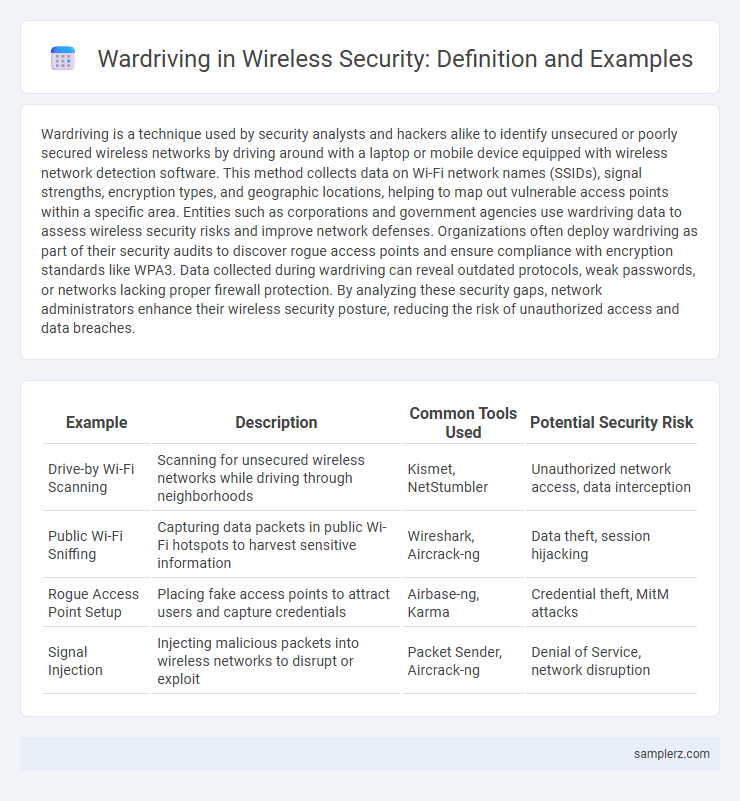Wardriving is a technique used by security analysts and hackers alike to identify unsecured or poorly secured wireless networks by driving around with a laptop or mobile device equipped with wireless network detection software. This method collects data on Wi-Fi network names (SSIDs), signal strengths, encryption types, and geographic locations, helping to map out vulnerable access points within a specific area. Entities such as corporations and government agencies use wardriving data to assess wireless security risks and improve network defenses. Organizations often deploy wardriving as part of their security audits to discover rogue access points and ensure compliance with encryption standards like WPA3. Data collected during wardriving can reveal outdated protocols, weak passwords, or networks lacking proper firewall protection. By analyzing these security gaps, network administrators enhance their wireless security posture, reducing the risk of unauthorized access and data breaches.
Table of Comparison
| Example | Description | Common Tools Used | Potential Security Risk |
|---|---|---|---|
| Drive-by Wi-Fi Scanning | Scanning for unsecured wireless networks while driving through neighborhoods | Kismet, NetStumbler | Unauthorized network access, data interception |
| Public Wi-Fi Sniffing | Capturing data packets in public Wi-Fi hotspots to harvest sensitive information | Wireshark, Aircrack-ng | Data theft, session hijacking |
| Rogue Access Point Setup | Placing fake access points to attract users and capture credentials | Airbase-ng, Karma | Credential theft, MitM attacks |
| Signal Injection | Injecting malicious packets into wireless networks to disrupt or exploit | Packet Sender, Aircrack-ng | Denial of Service, network disruption |
Introduction to Wardriving in Wireless Security
Wardriving involves searching for unsecured Wi-Fi networks while moving through urban areas using a laptop or mobile device equipped with wireless network detection software. This practice exposes vulnerabilities in wireless security by identifying unprotected access points that attackers can exploit for unauthorized access or data interception. Understanding wardriving highlights the importance of robust encryption protocols, such as WPA3, and strong password policies to safeguard wireless networks from intrusions.
How Wardriving Threatens Wireless Networks
Wardriving involves attackers driving through areas to detect unsecured or poorly protected wireless networks using specialized tools, posing significant risks to network confidentiality and integrity. These unauthorized inputs facilitate data interception, credential theft, and network infiltration, enabling cybercriminals to exploit sensitive information. The increasing use of insecure networks heightens vulnerability to wardriving, emphasizing the need for robust encryption protocols like WPA3 and proactive network monitoring.
Tools Commonly Used in Wardriving Attacks
Wardriving attacks commonly utilize tools such as Kismet, NetStumbler, and Aircrack-ng to detect and analyze unsecured wireless networks while on the move. These software applications enable attackers to capture wireless packets, identify network vulnerabilities, and crack WEP/WPA encryption keys efficiently. GPS integration with wardriving tools allows for mapping the exact locations of vulnerable access points, enhancing the accuracy of network exploitation.
Real-World Wardriving Incident Examples
In 2001, the hacker group "The Cult of the Dead Cow" demonstrated wardriving by mapping unsecured Wi-Fi networks across major U.S. cities, highlighting widespread vulnerabilities. Another notable incident occurred in 2004 when a wardriver exploited an open wireless network to breach a hospital's internal systems, compromising sensitive patient data. These real-world cases underscore the critical need for robust encryption protocols like WPA3 and regular network security audits to prevent unauthorized access.
Wardriving Techniques: From Discovery to Exploitation
Wardriving techniques involve using GPS-enabled devices and specialized software to detect and map unsecured wireless networks, often by driving through urban areas. Attackers exploit vulnerabilities such as weak encryption protocols (WEP) and default SSIDs to gain unauthorized access to wireless networks. Advanced methods include packet sniffing and injecting malicious payloads, enabling data interception and network compromise.
Legal and Ethical Implications of Wardriving
Wardriving involves searching for unsecured wireless networks by driving through specific areas with wireless-enabled devices, raising significant legal and ethical concerns. Unauthorized access to private networks can violate laws such as the Computer Fraud and Abuse Act (CFAA) in the United States, leading to criminal charges or civil penalties. Ethically, wardriving challenges privacy rights and emphasizes the need for robust wireless security measures to protect sensitive data from potential exploitation.
Organizations Impacted by Wardriving Attacks
Wardriving attacks significantly impact organizations by exposing unsecured wireless networks to unauthorized access, leading to data breaches and intellectual property theft. Companies in sectors such as finance, healthcare, and government are particularly vulnerable due to the sensitive nature of the information they handle. These breaches can result in financial losses, regulatory penalties, and long-term reputational damage.
Preventing Wardriving: Best Security Practices
Implementing strong WPA3 encryption and complex passwords significantly reduces wardriving risks by preventing unauthorized access to Wi-Fi networks. Disabling SSID broadcasting and enabling MAC address filtering further obscure network visibility from wardrivers. Regular firmware updates and using VPNs add extra layers of protection against wireless network intrusion attempts.
Wardriving and Wi-Fi Encryption Protocols
Wardriving involves searching for Wi-Fi networks by moving through an area using a vehicle equipped with a wireless scanner, exposing unsecured or weakly encrypted networks to potential attacks. Attackers exploit weak Wi-Fi encryption protocols like WEP and WPA to gain unauthorized access during wardriving, as these protocols have known vulnerabilities. Strong encryption standards such as WPA3 significantly reduce the risk of wardriving attacks by providing enhanced data protection and authentication mechanisms.
Future Trends in Wardriving and Wireless Security
Future trends in wardriving include the integration of AI-powered detection systems that can identify unauthorized access points more efficiently, enhancing wireless security protocols. Advances in machine learning algorithms enable real-time analysis of network vulnerabilities, reducing the risk of data breaches in Wi-Fi environments. Emerging standards such as WPA3 and enhanced encryption methods further strengthen defenses against wardriving techniques targeting wireless networks.

example of wardriving in wireless security Infographic
 samplerz.com
samplerz.com